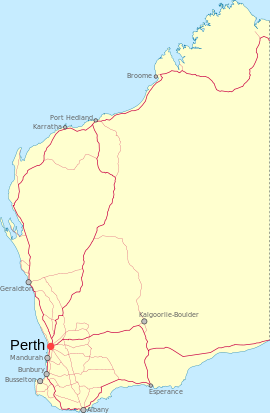- Narembeen, Western Australia
-
Narembeen
Western AustraliaPopulation: 469 (2006 Census))[1] Established: 1922 Postcode: 6369 Coordinates: 32°03′47″S 118°23′46″E / 32.063°S 118.396°ECoordinates: 32°03′47″S 118°23′46″E / 32.063°S 118.396°E Elevation: 280 m (919 ft) Location: - 286 km (178 mi) East of Perth
- 31 km (19 mi) South East of Bruce Rock
- 66 km (41 mi) South of Merredin
LGA: Shire of Narembeen State District: Central Wheatbelt Federal Division: O'Connor Narembeen is a town in the Western Australia wheatbelt. It is 286 km, almost due east, from Perth, the capital of WA. It is the major settlement in the Shire of Narembeen, in which the major industries are growing cereal crops and raising cattle and sheep.
Narembeen means place of female emus in the local Aboriginal language.
The area was initially surveyed in 1836 by the Surveyor General John Septimus Roe. After camping on a rocky outcrop and seeing a group of Emus he named the area Emu Hill. By the 1850s European settlers arrived in the area looking for pastoral land for wheat and grazing. Sandlewood cutters also frequented the area during this time.
In 1901 the rabbit proof fence was constructed just to the East of Narembeen and can still be seen today.
A settler named Charles Smith bought a property he called Narimbeen. By the 1900s more farmers moved to the area as land was opened upand by 1918 the town-site of Emu Hill was gazetted.
In 1920, the town-site of Narembeen only existed as a minor railway siding to the railway line that had only just been built to Emu Hill.[2]
By the 1920s Emu Hill was the largest community in the region but the local populace opposed the building of a hotel in the town.
As a result of this a Perth lawyer, Henry Dale and a Publican, Paddy Conlon, purchased 30 acres (120,000 m2) of land at the railway siding of Narembeen to build a hotel. The town ofNarembeen was established in 1922 about 5 km from the Emu hill town-site. The location of Narembeen was not the best choice as it is prone to flooding. In 1924, there were rumours that gold had been discovered close to the Rabbit Proof fence and the town of Holleton was established about 50 km from Narembeen , but Narembeen prospered as it was the closest train station to Holleton and offered a motor transport service to the miners.[3]
Narembeen had a population of 2,100 by 1925 and Emu Hill was no more.
In 1968 the town of Narembeen was officially declared.[4]
References
- ^ Australian Bureau of Statistics (25 October 2007). "Narembeen (L) (Urban Centre/Locality)". 2006 Census QuickStats. http://www.censusdata.abs.gov.au/ABSNavigation/prenav/LocationSearch?collection=Census&period=2006&areacode=UCL520400&producttype=QuickStats&breadcrumb=PL&action=401. Retrieved 2008-09-16.
- ^ "Sydney Morning Herald - Travel - Narembeen". The Sydney Morning Herald. 2004-02-08. http://www.smh.com.au/news/western-australia/narembeen/2005/02/17/1108500208587.html. Retrieved 2008-09-16.
- ^ "Shire of Narembeen - History". 2008. http://www.narembeen.wa.gov.au/our_council/history.html. Retrieved 2008-09-16.
- ^ "West Australian Vista - Narembeen - A Brief History of Narembeen". 2008. http://www.westaustralianvista.com/narembeen.html. Retrieved 2008-09-16.
Categories:- Towns in Western Australia
Wikimedia Foundation. 2010.

